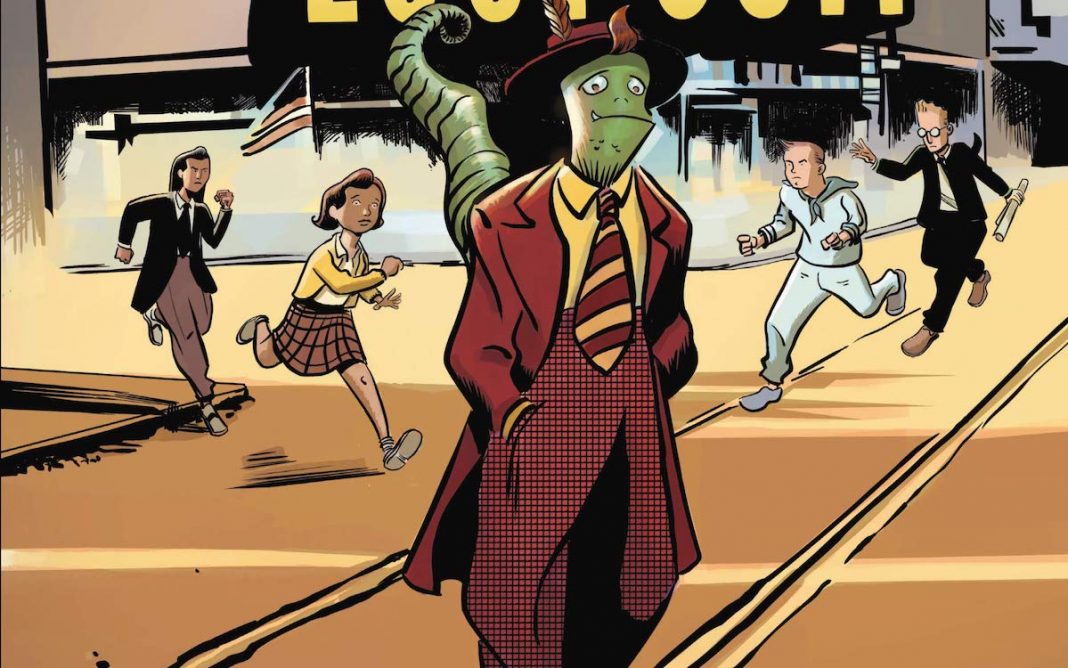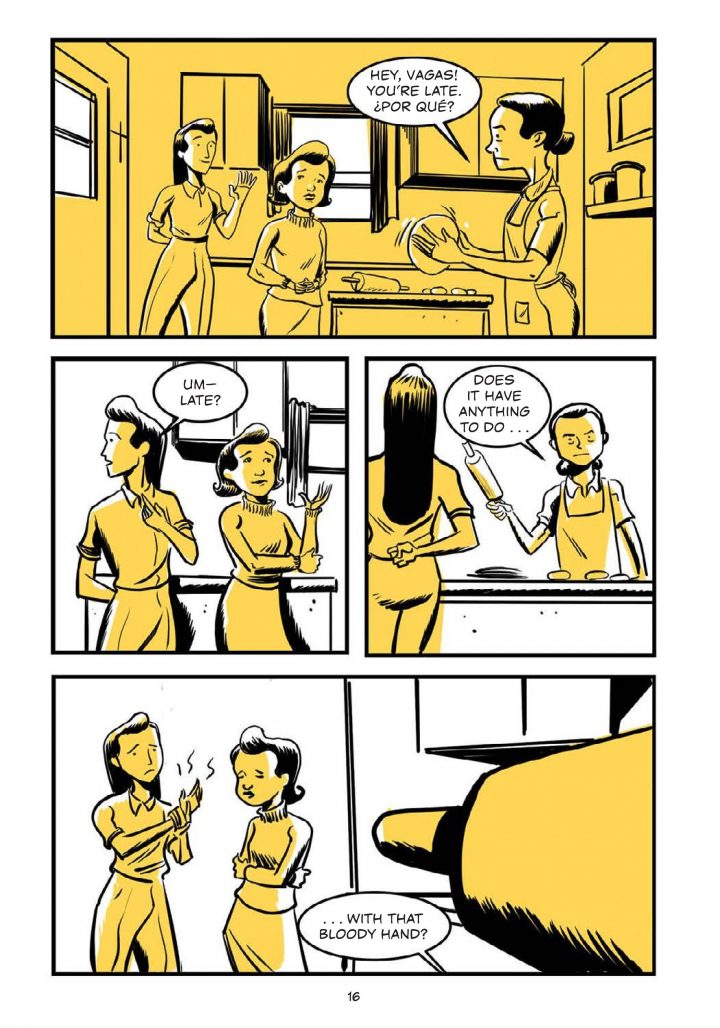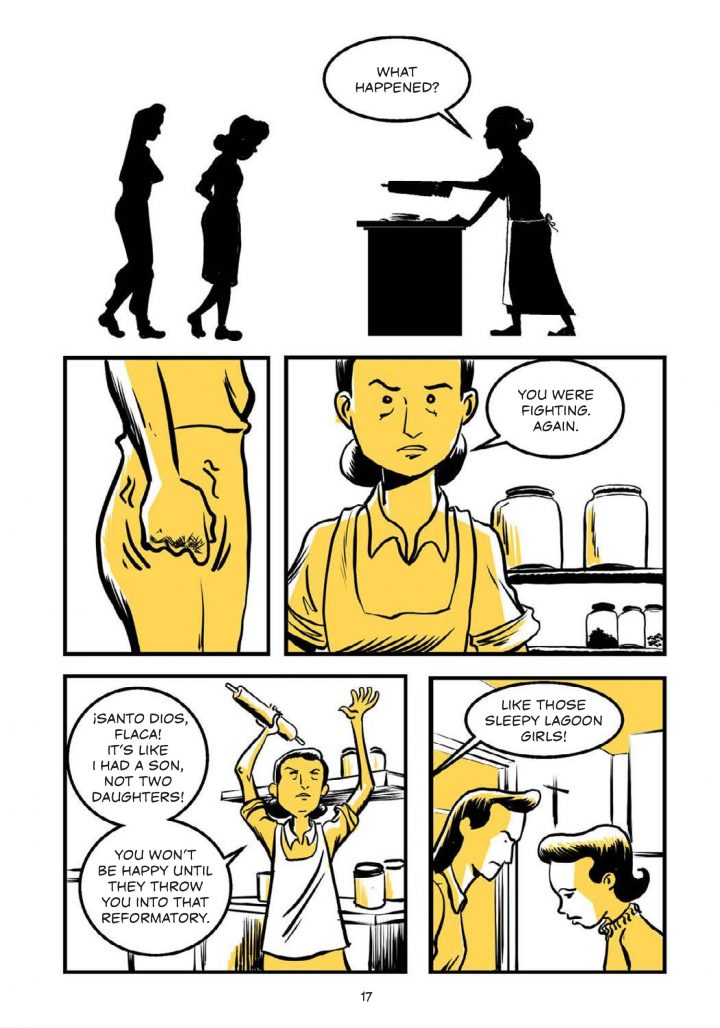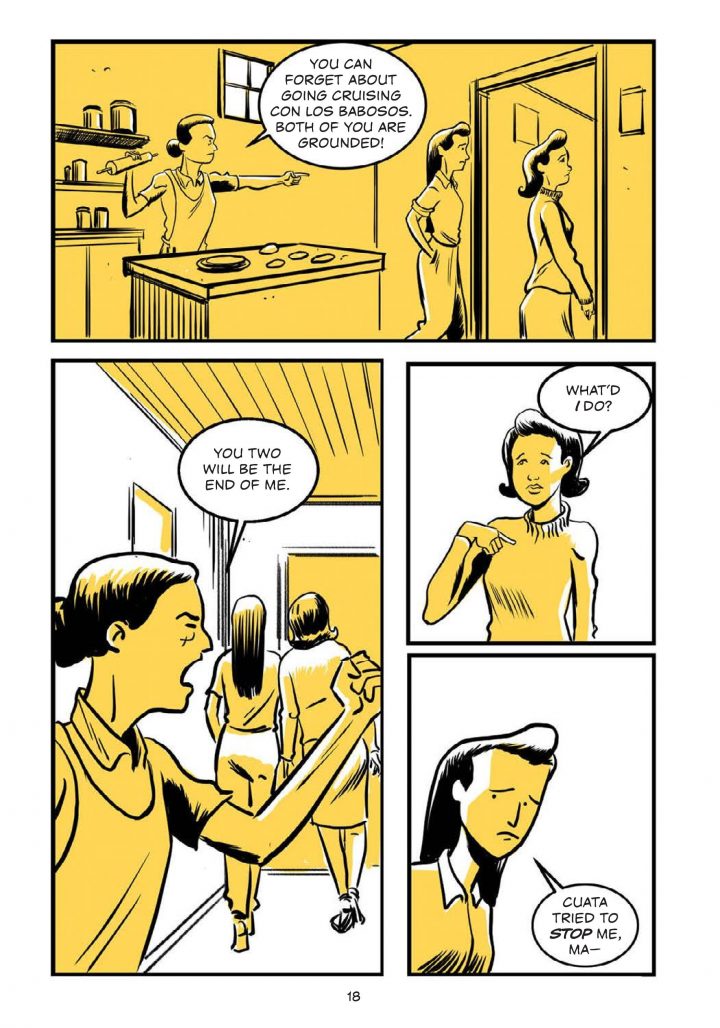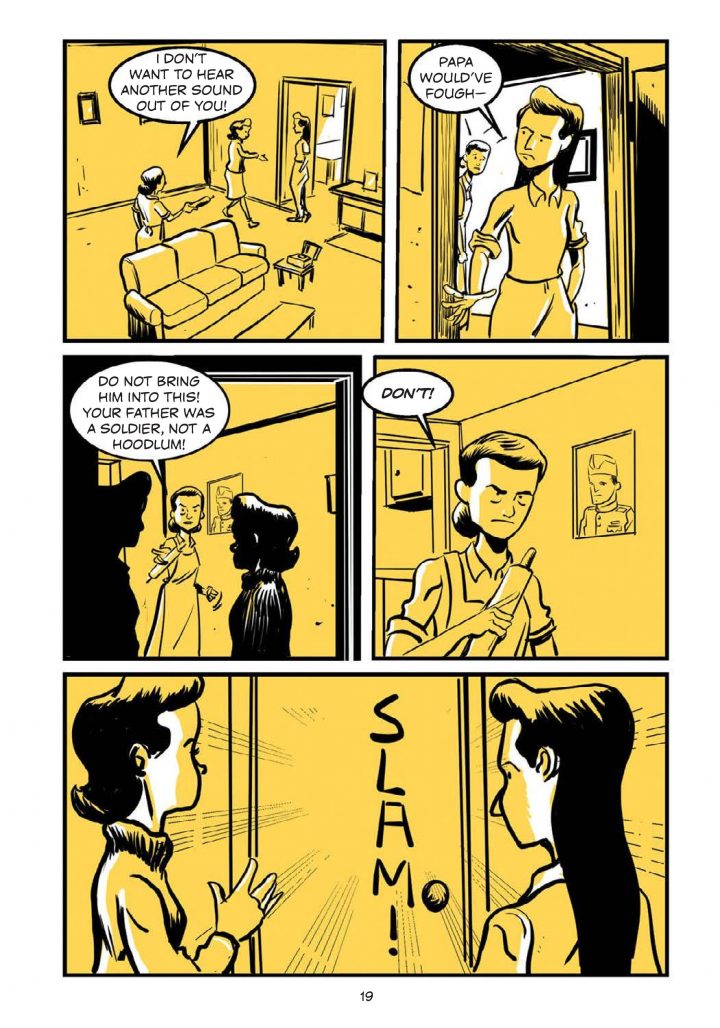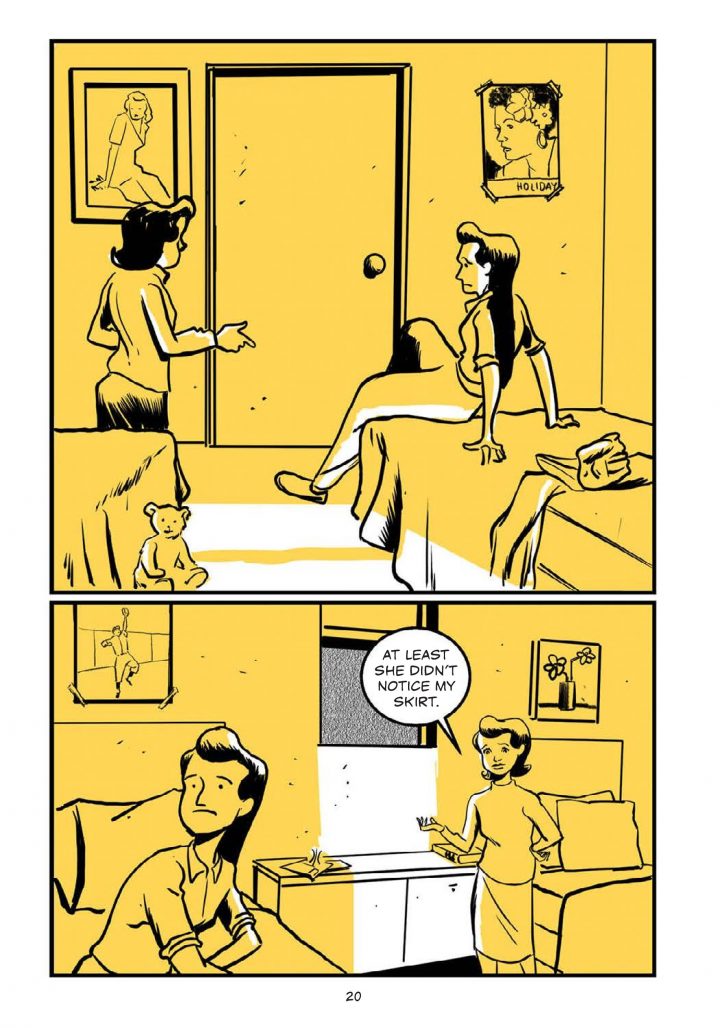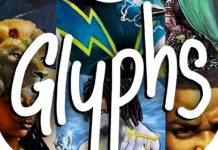Lizard in a Zoot Suit, the new book from cartoonist Marco Finnegan, sits at the intersection of a number of interesting topics.
It is, at its core, the story of a family, of two odd couple sisters specifically, but it’s also a story set against a historical fiction backdrop. Lizard in a Zoot Suit takes place during the 1943 Zoot Suit Riots, which was a five-day period of unrest and conflict that saw U.S. service members fights Mexican-American young people in Los Angeles. It was one of a number of race-related riots that took place that summer across the country, and it is to do this day one of the most significant events in Los Angeles and Mexican-American history.
What Finnegan’s new book does is impart that history on a YA audience, doing so by adding a sci-fi twist that is also rooted in the history of the area, but you can hear much more about that directly from Finnegan himself today in The Beat’s interview.
For those interested, Lizard in a Zoot Suit (which is an excellent graphic novel) is due out August 4 from book market retailers.
ZACK QUAINTANCE: So, I really enjoyed the book, and I’ve been clamoring for a while for comics to use history more often as a backdrop for stories. The book speaks for itself, but I still wanted to ask, what drew you to the “Sleepy Lagoon murder” and that era?
MARCO FINNEGAN: Thanks so much! The story came out of a mixture of things, including my desire to make an 80s type adventure story with Chicano characters. About the time I started coming up with story ideas I rewatched Luis Valdez’s Zoot Suit and read Culture Clash’s Chavez Ravine. I got really interested in that part of Los Angeles history and realized that it usually plays as a footnote in pop culture set in that time frame. One of things that really drives me is the idea of creating stories that represent folks that do not typically get to go on big adventures. If you look at the history of Chicano’s in pop culture we don’t see a lot of stories that are these types of adventures. I think this is extremely important when doing any kind of work but especially a YA book. Kids need to see themselves in these stories and I think Flaca and Cuata are very relatable to kids today. I wanted to shine a light on the Zoot Suit experience but I also wanted to show that the kids growing up in the neighborhoods were capable of the empathy and heroism of genre books and movies.
The Zoot Riots were sparked by a bunch of factors, the murder of Jose Diaz at the Sleepy Lagoon was the catalyst that allowed the media and the community to start villifying all Zoot Suiters. The kids were painted as baby gangsters and when the Navy Sailors started instigating fights between themselves and the Pachucos, mainstream America and the newspapers had no problem sculpting a narrative around heroic sailors protecting the American Way of life.
The animosity towards Zoot Suiters was ramped up because as the rest of America was rationing, these teens were buying flamboyant suits from underground tailors. That was their only crime…they bought suits with their own money, but sometimes that is the only spark that racism needs to turn violent.
Flaca and Cuata are two twin sisters who are living with an overprotective mother who has been widowed (their father, like many Mexican Americans lost his life in service to his country) and simply want to be a part of the Zoot Suit scene. As they are fleeing one of the many flare ups of violence during these riots, the girls stumble upon a mysterious lizard creature who is trying to find his family. At the heart of this story is an adventure story about family and loyalty, but i think it’s also a good introduction to a part of history that is often neglected.
QUAINTANCE: I thought the yellow, almost mustard, color palette worked really well, and for some reason in my head I’ve always associated that color with zoot suits. How did you decide on that color for the book?
FINNEGAN: I used the yellow for a couple of reasons, the first is that I always associated that tone with heat and I wanted it to feel like a hot summer day in Los Angeles. The second was the feeling of heat (I hoped) would create more tension as the story progressed, it’s not a really relaxing color and I hoped it would make us as uncomfortable as the characters in the story. Since this is a YA book that has one foot in reality and one in fantasy, I wanted the color scheme to be a bit more impressionistic rather than real. It’s neat that you associated it with Zoot Suits and I think it does feel like a color that would work as a Suit!
QUAINTANCE: I also found the family dynamics — especially between the sisters — really interesting. How did you develop that relationship?
FINNEGAN: The sisters are an amalgam of what I imagine my mom and her sisters were when they grew up in El Paso before coming to Southern California. They were close but they all seemed to be put into different boxes by those around them, one was a jock, one was a twin, one was wild, etc. I wanted to show how these boxes can be harmful to any kid, but especially during such a turbulent time as Los Angeles in the 1940s. These Pachucas sometimes had it rougher than the boys because while they were rebelling against mainstream american culture, they were also rebelling against some very patriarchal ideas of how young Mexican ladies should behave and dress. I really think that both of the girls have been trying to live up to an expectation put on them by others, while still being at the age when they are trying to figure out who they are as individuals.
The girls tease each other quite a bit, we see that playful banter and even the name calling (Flaca means “skinny”) and this was how my mom and aunts were when I was growing up. A lot of playful teasing that on the outside can seem mean but really is a sign of affection. They were also very protective of each other, with my mom being the most protective and her sisters being a bit more wild. At least that’s what she tells me…i hope she wasn’t the wild one!!
QUAINTANCE: Often when you hear “with a sci-fi twist”, it means something familiar is being added to sort of liven things up. What I was struck by here is that the adopted-lizard humanoid is a pretty novel twist. Where did the lizard come from?
FINNEGAN: The Lizard people came from a story I read about a miner named George Warren Shufelt who was convinced he had discovered one of several underground tunnels that were created by tribes of Mayan or Hopi Lizard people. He claimed, in a very Yosemite Sam way that, “that there was gold in them there tunnels” and if the city of Los Angeles let him dig underneath, he would share the treasure. Since this was during the depression i think they let him. I moved the myth forward about 10 years and had the tunnels run directly under the neighborhoods now known as Dodgers Stadium (Chavez Ravine).
I also wanted to put in a nod to the Lizard people who were forced out of their homes by humans, much like the residents of Chavez Ravine would soon be forced out of their homes in the name of progress as well.
Chulito was a blast to design too, he is like the distant cousin of the creature from the black lagoon…the Lizard from the Sleepy Lagoon. I wanted him to be innocent, unaware of what the riots were about and just wanting to get back with his family. With everything I designed in this book, I wanted to try and make it feel of its time, and using a Lizard design that could easily be a man in a rubber suit seemed to make sense!
QUAINTANCE: I noticed on your Twitter you’re also a teacher. How did your experiences as an educator help you with this book? It seems like a natural fit given how fun it manages to make history…
FINNEGAN: Being a teacher allows me to meet so many interesting kids from all different backgrounds and one thing I have noticed is that no matter who the kid is, they respond to being represented positively in pop culture. Understanding all of my students as individuals and getting to know their stories really has made me a better storyteller and teacher. As for this book in particular, I hope that kids will enjoy the story and want to learn more about this point in history, so many people have mentioned that they never knew about these riots or neighborhoods. The best way to slip in some teaching is by making it entertaining!


